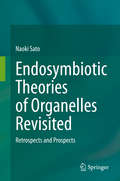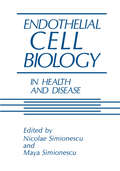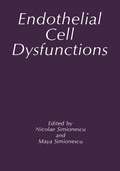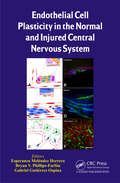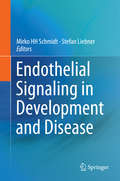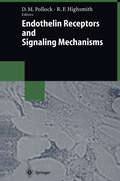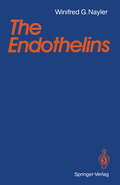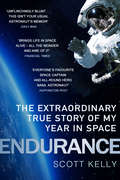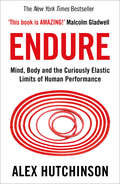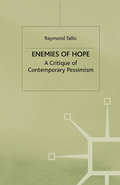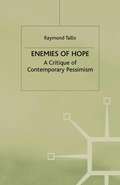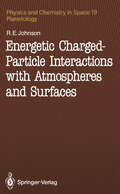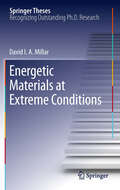- Table View
- List View
Endosymbiotic Theories of Organelles Revisited: Retrospects and Prospects
by Naoki SatoThis book re-examines the endosymbiotic theory, and presents various related theories and hypotheses since the first proposal in 1905 by a Russian biologist. It also demonstrates that Lynn Margulis’s contribution to the current endosymbiotic is less than sometimes thought, and presents a plausible idea on how the organelles were formed. Explaining that Margulis’s initial work did not intend to show the endosymbiotic origin of chloroplasts and mitochondria, the book discusses their endosymbiotic origin in the light of current biology with the help of clear visual images. Further, by including numerous historical facts and details of phylogenetic analyses using recent genomic data that are largely unknown to many in the field, it offers deep insights into the history of biology, phylogenetic analysis, and the new evolutionary thinking. 2017 was the 50-year anniversary of Margulis’s first paper in the Journal of Theoretical Biology, and 2020 will mark 50 years since the publication her famous work Origin of Eukaryotic Cells, and as such this book offers a timely reconsideration ofthe works of Lynn Margulis and the endosymbiotic origin of organelles.
Endothelial Cell Biology in Health and Disease
by M. Simionescu N. SimionescuAlthough blood capillaries were first observed through a flea-lens microscope by Malpighi in 1661,200 more years elapsed before the cellular nature of the vessel wall was conclusively demonstrated. Beginning with the middle of the 19th cen tury, our knowledge of the histological organization of blood vessels has steadily increased. However, the endothelium, which for a long time was considered to be just an inert barrier lining, had been barely explored until three decades ago. Since then, there has been an upsurge of interest in the fine structure and function of endothelial cells. Intense in vivo and in vitro investigations have revealed that the endothelial cell is a key element in a wide variety of normal activities and diseases. A large number of investigators and laboratories have been attracted to endothelial cell research, thus supporting the expansion of the continuously grow ing and diversifying field of endotheliology. The number of articles published annually on this subject has increased from a few score at the beginning of the 1970s to more than a thousand in recent years, and an increasing number of journals, books, societies, and symposia focused primarily on the vascular en dothelium have marked the last decade.
Endothelial Cell Dysfunctions
by M. Simionescu N. SimionescuNoted experts survey and evaluate the latest research in the growing field of endothelial cell involvement in the initiation and development of various diseases. Research-oriented chapters span a diversity of topics, including endothelial cell response to various injuries and its crucial role in inflammation, immunity, viral infection, hypertension, hyperlipidemia, atherosclerosis, diabetes mellitus, neoplasia, and metastasis.
Endothelial Cell Plasticity in the Normal and Injured Central Nervous System
by Esperanza Meléndez Herrera Bryan V. Phillips-Farfán Gabriel Gutiérrez OspinaThis book highlights the importance of endothelial cells as key players in the functioning of the nervous system under both normal and pathological conditions. The book demonstrates that endothelial cells are an essential and dynamic cell population in the central nervous system, with multiple and complex roles, not only in the maintenance of homeo
Endothelial Dysfunction and Inflammation (Progress in Inflammation Research)
by Shauna Dauphinee Aly KarsanEndothelial dysfunction is broadly defined as a disruption of the balance between vasoactive mediators and a propensity towards an inflammatory state. This volume provides an overview of the fields of endothelial dysfunction and inflammation through the discussion of topics ranging from the molecular biology of activated endothelial cells to the endothelium in inflammatory disease and therapeutic approaches targeting endothelial dysfunction. Topics include: Heterogeneity of the endothelium during inflammation, oxidative stress and endothelial dysfunction, biology and regulation of nitric oxide in inflammatory pathologies, endothelial dysfunction in inflammatory diseases, such as diabetes and atherosclerosis and Clinical methods used to assess endothelial function. This book brings together basic and clinical research to assist the reader in bridging connections from bench-to-bedside. Written by expert researchers in the fields of endothelial biology, inflammation research and clinical science, it serves as a useful reference for academic and industrial researchers, clinicians, and trainees in the medical profession.
Endothelial Progenitor Cells: A New Real Hope? (UNIPA Springer Series)
by Carmela Rita BalistreriThis book explores the role of endothelial progenitor cells (EPCs) in the context of regenerative medicine (RegMed). In particular, it reveals the value of RegMed as a new TM branch intended to improve the health and quality of life, by restoring, maintaining or enhancing tissue and functions of organs.The book is divided into three chapters, the first of which describes the relevance of translational medicine (TM) as a new research approach to counteract the imposing challengeof age-related diseases. Of the diverse RegMed approaches, particular attention is paid to stem/progenitor cell-based therapies, their benefits and shortcomings, as well as to the description of types of stem and progenitor cells considered for regenerative cell therapies, such as EPCs as emerging candidates for RegMed applications.In turn, the second chapter outlines the clinical relevance of EPCs as both potential predictors, diagnostic and prognostic biomarkers of age-related diseases and therapeutic agents,discussing their advantages, disadvantages, and conflicting data.Chapter three proposes a potential roadmap for revising the findings and creating a clearer picture of valid data, which can provide support for various important aspects, i.e.isolating and characterizing EPCs by establishing standardized criteria for EPC research, identifying appropriate sub-populations for cell therapy, timing, dosing, priming of cells,and defining delivery modes for different applications. The book concludes with an overview of innovative strategies that could improve the efficacy of cell therapy at all levels, including cell priming, bio-nanotechnology, and tissue engineering.
Endothelial Signaling in Development and Disease
by Mirko Hh Schmidt Stefan LiebnerThis book surveys healthy and diseased vascular systems in a multitude of model organisms and systems. It explores a plethora of functions, characteristics, and pathologies of the vascular system such as angiogenesis, fibroblast growth factor signaling, lymphangiogenesis, junctional signaling, the extracellular matrix, vascular permeability, leukocyte extravasation, axon guidance factors, the angiopoietin system, and chronic obstructive lung disease. Following a preface from leading researcher Dr. Holger Gerhardt, the text is divided into three sections- the first examining the development of the vascular system in a variety of contexts, the second delving into its homeostatic characteristics, and the third discussing its pathophysiologies. The sixteen chapters, which represent international clinical and research perspectives, highlight the importance of molecular and signaling pathways for translational basic science and clinical medicine. Additionally, the text explores new and exciting fields in vascular biology research. Comprehensive in both content and approach, Vascular Signaling in Health and Disease is ideal for graduate students, researchers, and clinicians interested in vascular biology, pneumology, and molecular biology.
Endothelin and Its Inhibitors (Handbook of Experimental Pharmacology #152)
by Timothy D. WarnerRecent publications have addressed specific aspects of the endothelins, such as their roles in disease or the importance of endothelin receptors. However, in this book the entire field of endothelins is covered. This includes the pathways of endothelin production and their regulation, the local and systemic actions of endothelins, receptors for the endothelins and the signalling pathways employed, and the involvement of endothelins in a range of diseases. Attention is also paid to the development through chemistry, pharmacology and toxicology of endothelin antagonists and endothelin-converting enzyme inhibitors, with mention of all the important members of these drug classes. This leads to well-rounded discussions of the potential therapeutic benefit of endothelin inhibitors.
The Endothelins
by Winifred G. Nayler"What we call the beginning is often the end, and to make an end is to make a beginning. The end is where we start from." T. S. ELIOT, "Geroniton" The discovery of endothelin-l was both an end and a beginning. It is an end because this discovery has started a plethora of investigations as to endothe1in's sites of production, mode of action, it's normal and abnormal physiological role and its involvement in a variety of pathological conditions ranging from renal failure to myocardial infarction, cardiac hypertrophy, hyperten sion, cyclosporine induced toxicity, mental depression, renal failure, stress related illness, and even stroke and sudden death. It is a beginning because no one can foresee where the investigations will ultimately lead, or how they will end. The discovery of the endothelins was a very recent event and soon specialist books will start to appear dealing in detail with different aspects of their chemistry, physiological role and pathological importance. The present book is intended to act as a guide and primer for those who are becoming intrigued by the many endothelin related articles which are now appearing in the journals but who as yet have not had the time or opportunity to be caught up in the web of enthusiasm and excitement which is motivating those more directly involved in the field of research.
Endotoxine und Pyrogene: Nachweisverfahren, Produktprüfung, Inaktivierung
by Michael RiethDiese erste deutschsprachige Übersicht beschreibt praxisnah alle verfügbaren und in der europäischen Pharmakopöe aufgenommenen Nachweisverfahren für bakterielle Endotoxine und andere Pyrogene. Jede Methode wird ausführlich beschrieben und anhand von Praxisbeispielen einschließlich der produktbezogenen Methodenvalidierung präsentiert. Neueste Erkenntnisse zur Maskierung von Endotoxinen und dem LER (low endotoxin recovery)-Effekt sowie neuentwickelte Methoden zur Endotoxinbestimmung mittels rekombinanter Testsysteme werden vorgestellt. Eine Beschreibung der notwendigen Ausrüstung sowie der hauptsächlichen Einsatzgebiete runden dieses Buch ab.
Endotoxine und Pyrogene: Nachweisverfahren, Produktprüfung, Inaktivierung
by Michael RiethDiese erste deutschsprachige Übersicht beschreibt praxisnah alle verfügbaren und in der europäischen Pharmakopöe aufgenommenen Nachweisverfahren für bakterielle Endotoxine und andere Pyrogene. Jede Methode wird ausführlich beschrieben und anhand von Praxisbeispielen einschließlich der produktbezogenen Methodenvalidierung präsentiert. Neueste Erkenntnisse zur Maskierung von Endotoxinen und dem LER (low endotoxin recovery)-Effekt sowie neuentwickelte Methoden zur Endotoxinbestimmung mittels rekombinanter Testsysteme werden vorgestellt. Eine Beschreibung der notwendigen Ausrüstung sowie der hauptsächlichen Einsatzgebiete runden dieses Buch ab.
Endotoxins: Pyrogens, LAL Testing and Depyrogenation
by Kevin L. WilliamsThis source expertly examines the discovery, biological structure, control, and continued clarification of endotoxin from a parenteral manufacturing perspective, with in-depth discussion of state-of-the-art technologies involving Limulus amebocyte lysate (LAL) such as assay development, automation, depyrogenation. Completely revised and exp
Endovascular Treatment of Arterial Emergencies
by Stevo DuvnjakThis book presents a practical overview of the widely used endovascular treatment of arterial emergencies, covering the majority of cases encountered in praxis. Including a wealth of high-quality images of arterial emergencies and treatment descriptions, it provides readers with essential information and shares insights into endovascular options. However, the book focuses on presenting common arterial emergencies from diagnosis to treatment only, without exhaustively describing all endovascular options. The clinical cases explore thoracic arterial emergencies, followed by abdominal emergencies and peripheral arterial emergencies. Rare clinical cases are also examined. The book offers interventional radiologists, vascular surgeons and cardiologists, as well as residents in these disciplines, a valuable tool for use in their everyday clinical praxis.
Endstadien der Sternentwicklung. Quantenmechanische Rotationsanregungen in Kristallen (Nordrhein-Westfälische Akademie der Wissenschaften)
by Volker WeidemannEndurance: A Year in Space, A Lifetime of Discovery
by Scott Kelly*As featured on BBC Breakfast, Radio 5Live and Steve Wright in the Afternoon on BBC Radio 2*From the Nasa astronaut who spent a record-breaking year aboard the International Space Station – what it’s like out there and what it’s like now, back here. Enter Scott Kelly's fascinating world and dare to think of your own a little differently.As soon as you realize you aren’t going to die, space is the most fun you’ll ever have...The veteran of four space flights and the American record holder for most consecutive days spent in space, Scott Kelly has experienced things very few of us ever have and very few of us ever will. Kelly's humanity, compassion, humour, and passion shine as he describes navigating the extreme challenge of long-term spaceflight, both existential and banal. He touches on what’s happened to his body, the sadness of being isolated from everyone he loves; the pressures of constant close cohabitation; the catastrophic risks of colliding with space junk, and the still more haunting threat of being absent should tragedy strike at home. From a natural storyteller Endurance is one of the finest examples the triumph of the human imagination, the strength of the human will, and the boundless wonder of the galaxy.*What readers are saying...'Takes you up into space and lets you be a part of astronaut life''Tough to put down! Tells a side you don't often hear or read about for that matter''Mind blowing . . . up there with Ernest Shackleton for me''My husband said it is the next best thing to going into space yourself''Six stars!'
Endure: Mind, Body, And The Curiously Elastic Limits Of Human Performance
by Alex Hutchinson‘This book is AMAZING!’ – MALCOLM GLADWELL ‘If you want to gain insight into the mind of great athletes, adventurers, and peak performers then prepare to be enthralled by Alex Hutchinson’s Endure.’ – BEAR GRYLLS
Enemies of Hope: A Critique of Contemporary Pessimism
by R. TallisPerceptive, passionate and often controversial, Raymond Tallis's latest debunking of Kulturkritik delves into a host of ethical and philosophical issues central to contemporary thought, raising questions we cannot afford to ignore. After reading Enemies of Hope , those minded to misrepresent mankind in ways that are almost routine amongst humanist intellectuals may be inclined to think twice. By clearing away the 'hysterical humanism' of the present century Enemies of Hope frees us to start thinking constructively about the way forward for humanity in the next.
Enemies of Hope: A Critique of Contemporary Pessimism
by R. TallisOver the last few years, Raymond Tallis has published widely acclaimed critiques of influential trends in contemporary thought: for example, Not Saussure - described as 'one of the most brilliant and effective of all rebuttals of post-Saussurean theory' - In Defence of Realism and The Explicit Animal, which demonstrated the baselessness of contemporary accounts of consciousness. Enemies of Hope takes the story further, identifying the themes common to anti-humanist twentieth-century thought and challenging the cult of pessimism that pervades our age. Tallis teases out the many strands of the comfortable, self-congratulatory cynicism of modernist and postmodernist cultural critics, exposing their self-contradictions and their wilful blindness to the distinctive mystery of human nature. The 'pathologisers of culture' and 'the marginalisers of consciousness' are shown to be the enemies of hope - the hope of progress based upon the rational, conscious endeavours of humankind. Perceptive, passionate and often controversial, Raymond Tallis's latest debunking of Kulturkritik explores a host of ethical and philosophical issues central to contemporary thought, raising questions we cannot afford to ignore. After reading Enemies of Hope, those minded to misrepresent mankind in ways that are almost routine amongst humanist intellectuals may be inclined to think twice. By clearing away the hysterical anti-humanism of the twentieth century Enemies of Hope frees us to start thinking constructively about the way forward for humanity in the twenty-first.
Energetic Charged-Particle Interactions with Atmospheres and Surfaces (Physics and Chemistry in Space #19)
by Robert E. JohnsonOn attending a conference on the Jovian satellites at UCLA, I heard Lou Lanze rotti vigorously present the exciting data on the sputtering of water ice by Me V protons taken with W. L. Brown at AT&T Bell Labs. In his inimitable way he made clear that this new electronic sputtering process was very poorly under stood and was very important for surface properties of sattelites. I was immedia tely hooked, and have been working ever since with Lanzerotti, Brown, my col league at Virginia, John Boring, and Bo Sundqvist at Uppsala on understanding the ejection of material from surfaces and applying laboratory results to intere sting planetary problems. In the course of writing this book I also had the benefit of spending a semester with the Planetary Geosciences group in Hawaii, thanks to Tom McCord, a period of time with Doug Nash at JPL, and a period ot time with the group at Catania. The book was started with the encouragement of Lou Lanzerotti. The writing has gone slowly as the field has been changing rapidly. Even now I feel it is incom plete, as the interesting Halley dust data have just recently been interpreted in detail, Voyager has recently visited Neptune, and the data on Pluto are rapidly improving. However, most of the principles for plasma ion alteration of surfaces and gases have been established allowing, I hope, a coherent and useful frame work for incorporating both new laboratory and planetary data.
Energetic Materials: From Cradle to Grave (Challenges and Advances in Computational Chemistry and Physics #25)
by Manoj K. Shukla Veera M. Boddu Jeffery A. Steevens Reddy Damavarapu Jerzy LeszczynskiThis book offers a comprehensive account of energetic materials, including their synthesis, computational modeling, applications, associated degradation mechanisms, environmental consequences and fate and transport. This multi-author contributed volume describes how armed forces around the world are moving their attention from legacy explosive compounds, which are heat and shock sensitive (thus posing greater challenges in terms of handling and storage), to the insensitive munitions compounds/formulations such as insensitive munitions explosive (IMX) and the Picatinny Arsenal Explosive (PAX) series of compounds. The description of energetic materials focuses on explosives, pyrotechnic compositions, and propellants. The contributors go on to explain how modern generation energetic compounds must be insensitive to shock and heat but at the same time yield more energy upon explosion. Nanoinspired and/or co-crystallized energetic materials offer another route to generate next-generation energetic materials, and this authoritative book bridges a large gap in the literature by providing a comprehensive analysis of these compounds. Additionally, it includes a valuable overview of energetic materials, a detailed discussion of recent advances on future energetic compounds, nanotechnology in energetic materials, environmental contamination and toxicity, assessment of munitions lethality, the application quantitative structure–activity relationship (QSAR) in design of energetics and the fate and transport of munition compounds in the environment.
Energetic Materials: Particle Processing and Characterization
by Ulrich TeipelIncorporation of particular components with specialized properties allows one to tailor the end product's properties. For instance, the sensitivity, burning behavior, thermal or mechanical properties or stability of energetic materials can be affected and even controllably varied through incorporation of such ingredients. This book examines particle technologies as applied to energetic materials such as propellants and explosives, thus filling a void in the literature on this subject. Following an introduction covering general features of energetic materials, the first section of this book describes methods of manufacturing particulate energetic materials, including size reduction, crystallization, atomization, particle formation using supercritical fluids and microencapsulation, agglomeration phenomena, special considerations in mixing explosive particles and the production of nanoparticles. The second section discusses the characterization of particulate materials. Techniques and methods such as particle size analysis, morphology elucidation and the determination of chemical and thermal properties are presented. The wettability of powders and rheological behavior of suspensions and solids are also considered. Furthermore, methods of determining the performance of particular energetic materials are described. Each chapter deals with fundamentals and application possibilities of the various methods presented, with particular emphasis on issues applicable to particulate energetic materials. The book is thus equally relevant for chemists, physicists, material scientists, chemical and mechanical engineers and anyone interested or engaged in particle processing and characterization technologies.
Energetic Materials and Munitions: Life Cycle Management, Environmental Impact, and Demilitarization
by Adam Stewart CummingProvides a hands-on approach to demilitarization and environmental aspects of energetic materials and munitions This book gives an overview of the environmental impact of the production, use, and cleanup of energetic materials and munitions. It provides scientists, engineers, environmental specialists, and users with the understanding of environmental issues for munitions and of the ways to improve design and manage potential risks. It covers the various aspects of how chemical properties influence fate, transport, and toxicity of new formulations and prescribes tools for reducing or alleviating environmental risks. In addition, it discusses pyrotechnics and the problem of dealing with munitions underwater. Chapters in Energetic Materials and Munitions: Life Cycle Management, Environmental Impact and Demilitarization look at demilitarization in general, as well as in the future. Topics covered include logistics, costs, and management; life cycle analysis and management; and greener munitions. Another introduces readers to the "One Health" approach in the design of sustainable munition compounds. Following that, readers are taught about land assessment for munitions-related contamination in military live-fire training. The book also examines the development and integration of environmental, safety, and occupational health information. -Brings together in one source expertise and in-depth information on the current and future state of how we handle the production, use, and demilitarization of explosives and weaponry -A handy reference for experienced practitioners, as well as for training young professionals in the field -Every chapter contains real-life examples and proposes future directions for the field Energetic Materials and Munitions: Life Cycle Management, Environmental Impact and Demilitarization is an important book for explosives specialists, pyrotechnicians, materials scientists, military authorities, safety officers, health officers, and chemical engineers.
Energetic Materials and Munitions: Life Cycle Management, Environmental Impact, and Demilitarization
by Adam Stewart Cumming Mark S. JohnsonProvides a hands-on approach to demilitarization and environmental aspects of energetic materials and munitions This book gives an overview of the environmental impact of the production, use, and cleanup of energetic materials and munitions. It provides scientists, engineers, environmental specialists, and users with the understanding of environmental issues for munitions and of the ways to improve design and manage potential risks. It covers the various aspects of how chemical properties influence fate, transport, and toxicity of new formulations and prescribes tools for reducing or alleviating environmental risks. In addition, it discusses pyrotechnics and the problem of dealing with munitions underwater. Chapters in Energetic Materials and Munitions: Life Cycle Management, Environmental Impact and Demilitarization look at demilitarization in general, as well as in the future. Topics covered include logistics, costs, and management; life cycle analysis and management; and greener munitions. Another introduces readers to the "One Health" approach in the design of sustainable munition compounds. Following that, readers are taught about land assessment for munitions-related contamination in military live-fire training. The book also examines the development and integration of environmental, safety, and occupational health information. -Brings together in one source expertise and in-depth information on the current and future state of how we handle the production, use, and demilitarization of explosives and weaponry -A handy reference for experienced practitioners, as well as for training young professionals in the field -Every chapter contains real-life examples and proposes future directions for the field Energetic Materials and Munitions: Life Cycle Management, Environmental Impact and Demilitarization is an important book for explosives specialists, pyrotechnicians, materials scientists, military authorities, safety officers, health officers, and chemical engineers.
Energetic Materials at Extreme Conditions (Springer Theses)
by David I.A. MillarDavid I.A. Millar's thesis explores the effects of extreme conditions on energetic materials. His study identifies and structurally characterises new polymorphs obtained at high pressures and/or temperatures. The performance of energetic materials (pyrotechnics, propellants and explosives) can depend on a number of factors including sensitivity to detonation, detonation velocity, and chemical and thermal stability. Polymorphism and solid-state phase transitions may therefore have significant consequences for the performance and safety of energetic materials. In order to model the behaviour of these important materials effectively under operational conditions it is essential to obtain detailed structural information at a range of temperatures and pressures.
